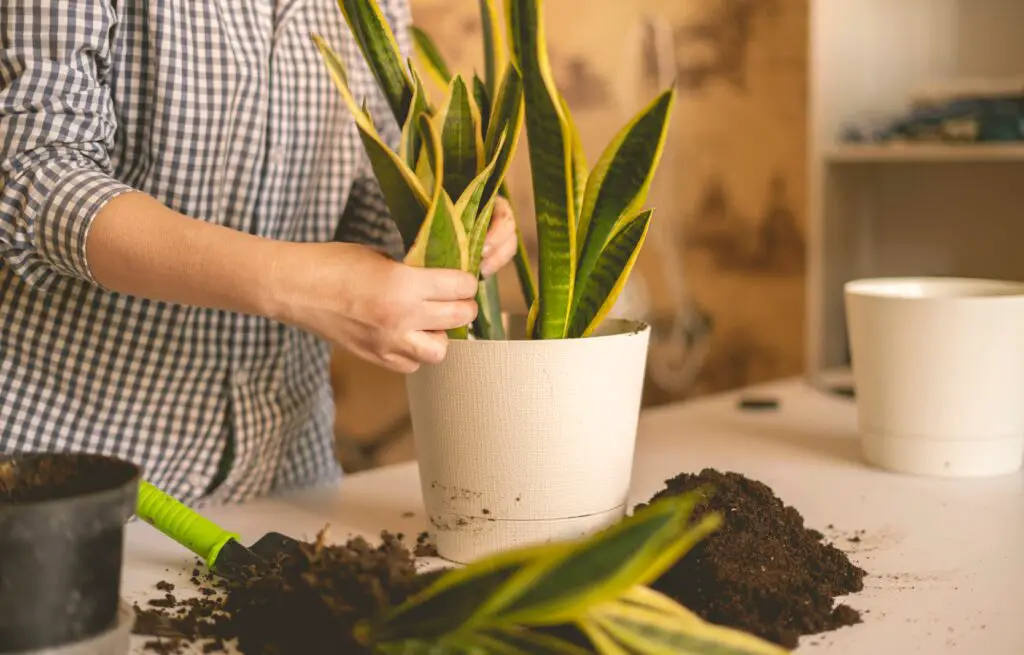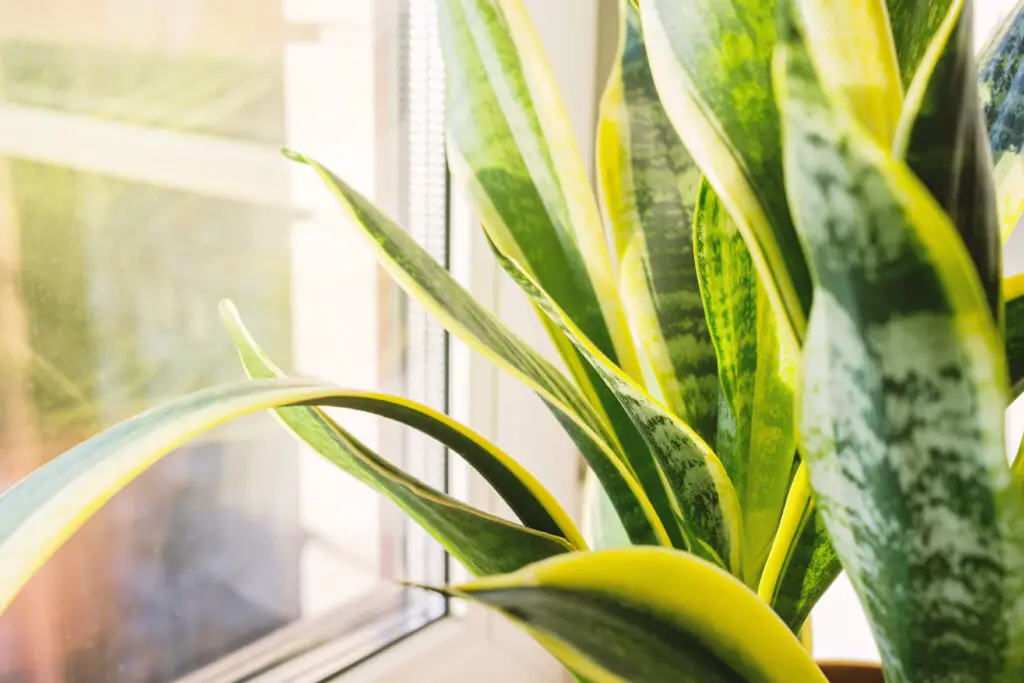Snake plants are a popular houseplant known for their durability and low maintenance. However, even the most robust plants can develop issues, and one of the most common problems with snake plants is yellowing leaves.
Yellowing leaves can be a sign of several issues, from overwatering to inadequate lighting, and it is essential to diagnose the problem quickly to prevent further damage.
Identifying yellow leaves in snake plants is the first step in addressing the issue. Snake plants can be sensitive to changes in their environment, and yellowing leaves are often an early sign that something is wrong.
Common causes of yellowing leaves include overwatering, too much or too little light, pests, and poor soil quality. Interpreting the symptoms and identifying the underlying cause is crucial to addressing the problem and preventing future yellowing.
Key Takeaways on Snake Plant Dying Yellow Leaves
- Yellowing leaves can be a sign of several issues, from overwatering to inadequate lighting.
- Common causes of yellowing leaves include overwatering, too much or too little light, pests, and poor soil quality.
- Interpreting the symptoms and identifying the underlying cause is crucial to addressing the problem and preventing future yellowing.
You will also like:
Identifying Yellow Leaves in Snake Plants

Yellow leaves in snake plants are a common symptom of a dying plant. It is important to identify the cause of the yellowing leaves in order to save the plant. Here are some ways to identify yellow leaves in snake plants.
Symptoms
Yellowing of the leaves is the most obvious symptom of a dying snake plant. However, it is important to observe and notice other features of the damaged leaf. For example, did the tips of the leaf first turn yellow? Are there dry brownish edges along with yellowness? These observations help to identify the exact cause of the problem.
Causes
There are several reasons why snake plant leaves turn yellow. Here are some of the most common causes:
- Overwatering: Snake plants are drought-tolerant and do not require frequent watering. Overwatering can lead to root rot, which can cause yellow leaves.
- Underwatering: While snake plants can tolerate drought, they still require some water. Underwatering can cause the leaves to turn yellow and dry out.
- Too much or too little light: Snake plants can adapt to full sun or lower-light conditions, but they grow best with bright, indirect light. Pale, yellow, or brown spots on otherwise healthy green leaves can indicate sunburn from too much direct sunlight.
- Inconsistent temperature: Snake plants prefer warm temperatures and can be damaged by cold drafts or extreme temperature fluctuations.
- Nutrient deficiency: Snake plants require very little fertilizer, but if they are not receiving enough nutrients, the leaves may turn yellow.
Treatment
The treatment for yellow leaves in snake plants depends on the cause. Here are some general tips:
- Check the soil moisture: If the soil is too wet, allow it to dry out before watering again. If the soil is dry, water the plant.
- Adjust the light: Move the plant to a location with brighter or less direct light, depending on the cause of the yellowing leaves.
- Adjust the temperature: Keep the plant away from cold drafts and extreme temperature fluctuations.
- Fertilize the plant: Use a balanced, water-soluble fertilizer once a month during the growing season.
Common Causes of Yellowing Leaves

Yellowing leaves are a common problem with snake plants. Several factors can cause yellow leaves, including overwatering, underwatering, temperature, sunlight, nutrient deficiencies, pests, and diseases.
Overwatering is one of the most common causes of yellowing leaves in snake plants. When the plant is overwatered, the roots become waterlogged, leading to root rot. This can cause the leaves to turn yellow and mushy. To avoid overwatering, make sure the soil is well-draining and allow the soil to dry out between waterings.
Underwatering is another common cause of yellowing leaves in snake plants. When the plant is underwatered, the leaves become dry and papery, and the tips may curl up. To avoid underwatering, make sure the soil is moist but not waterlogged.
Temperature can also cause yellowing leaves in snake plants. Cold temperatures can cause the leaves to turn yellow and die. On the other hand, too much direct sunlight can cause sunburn and yellowing of the leaves. To avoid these problems, keep the plant in a location with consistent temperatures and indirect sunlight.
Nutrient deficiencies can also cause yellowing leaves in snake plants. Lack of nitrogen, potassium, or other nutrients can cause the leaves to turn yellow and die. To avoid nutrient deficiencies, make sure the plant is fertilized regularly with a balanced fertilizer.
Pests and diseases can also cause yellowing leaves in snake plants. Mealybugs, spider mites, thrips, and aphids can infest the plant and cause yellowing of the leaves. Fungal diseases can also cause yellowing and mushy leaves. To avoid these problems, inspect the plant regularly for signs of pests and diseases and treat them promptly.
Interpreting the Symptoms
When a snake plant starts to exhibit yellow leaves, it is a sign that something is wrong. Understanding the symptoms can help identify the underlying problem and take corrective action. Here are some common symptoms associated with dying snake plant leaves:
- Yellowing Leaves: Yellowing of snake plant leaves is a common symptom that can indicate a range of problems. It can be caused by overwatering, underwatering, or chlorosis, which is a condition where the plant lacks sufficient nutrients.
- Drooping Leaves: Drooping leaves are another symptom of a dying snake plant. This can be caused by overwatering, underwatering, or exposure to extreme temperatures.
- Curling Leaves: Curling leaves are a sign that the plant is under stress. This can be caused by a lack of water, exposure to extreme temperatures, or pest infestations.
- Unhealthy Appearance: An unhealthy appearance can be caused by a range of problems. It can be due to overwatering, underwatering, exposure to extreme temperatures, or pest infestations.

To determine the cause of the problem, it is important to observe the plant carefully and note any changes in its appearance. This can help identify the underlying issue and take corrective action.
If the plant is overwatered, it is important to reduce the frequency of watering and ensure that the soil is well-drained. If the plant is underwatered, it should be watered more frequently.
If the plant is suffering from chlorosis, it may be necessary to fertilize the plant with a balanced fertilizer to provide the necessary nutrients.
In some cases, it may be necessary to repot the plant to provide it with fresh soil and room to grow. This can help revive a dying snake plant and restore it to health.
Addressing the Problem
Yellowing leaves are a common sign of stress in snake plants, also known as Sansevieria trifasciata or Dracaena trifasciata. If the leaves of a snake plant are turning yellow, it is important to address the problem quickly to prevent further damage to the plant.
One of the first steps in addressing the problem is to check the watering schedule. Overwatering or underwatering can cause yellowing leaves.
The soil should be allowed to dry out between waterings, and the plant should be watered thoroughly but not excessively. It is also important to ensure that the pot has drainage holes to prevent water from accumulating at the base of the plant.
Another factor to consider is the soil. Snake plants prefer well-draining soil with a pH between 6.0 and 7.5. A soil mix of potting soil and perlite can provide the necessary drainage. Repotting the plant can also help to address the issue, especially if the roots are overcrowded or if the soil has become compacted.
In addition to watering and soil, light can also play a role in yellowing leaves. Snake plants prefer indirect sunlight or shade, and too much direct sunlight can cause the leaves to turn yellow. Moving the plant to a location with indirect light can help to prevent further yellowing.
Fertilizer can also be a factor in yellowing leaves. Overfertilization can cause burns on the leaves and lead to yellowing. A balanced fertilizer should be used sparingly, following the instructions on the label. Neem oil can also be used to prevent pests that can cause yellowing.
Prevention is key to keeping snake plants healthy. This includes maintaining a consistent watering schedule, using well-draining soil, ensuring proper lighting, and avoiding overfertilization. Regular pruning can also help to prevent yellowing leaves and promote variegation.
If a snake plant is already experiencing yellowing leaves, repotting, adjusting the watering schedule, and addressing any pest issues can help to revive the plant. Maintaining a temperature range of 70-90 °F and monitoring soil moisture can also help to prevent further yellowing.
Preventing Future Yellowing
Preventing future yellowing of snake plant leaves is crucial to ensure the plant’s longevity and health. Here are some tips to prevent yellowing:
1. Watering

Overwatering is one of the most common reasons for yellowing snake plant leaves. To prevent this, one should water the plant only when the top two inches of soil are dry. It is essential to avoid watering the plant too frequently or leaving it in standing water.
2. Soil
The soil is another essential factor in preventing yellowing snake plant leaves. Snake plants require well-draining soil to prevent waterlogging and root rot. One can use a well-draining potting mix with perlite or sand to improve drainage.
3. Sunlight
Snake plants prefer indirect sunlight and can tolerate low light conditions. Direct sunlight can cause the leaves to burn and turn yellow. Therefore, it is best to place the plant in an area with bright, indirect light.
4. Fertilizer
Overfertilizing can also cause yellowing snake plant leaves. It is best to fertilize the plant only during the growing season, which is from spring to summer. One can use a balanced liquid fertilizer and dilute it to half strength.
5. Repotting
Repotting the plant every two to three years can also prevent yellowing snake plant leaves. When repotting, one should choose a container with drainage holes and use well-draining soil.
6. Humidity

Snake plants can tolerate low humidity levels, but higher humidity can promote growth and prevent yellowing leaves. One can increase humidity levels by placing a tray of water near the plant or using a humidifier.
By following these tips, one can prevent yellowing snake plant leaves and ensure a healthy and thriving plant.
Conclusion
Yellow leaves on a snake plant can be a sign of various issues, such as overwatering, poor drainage, low humidity, low temperature, and pest infestations. It is crucial to identify the underlying cause and address it promptly to prevent the plant from dying.
If the yellow leaves are due to overwatering, the plant may need to be repotted in well-draining soil and watered less frequently. If the issue is low humidity, the plant can benefit from a humidifier or a pebble tray. In the case of pest infestations, the affected leaves should be removed, and the plant should be treated with an appropriate insecticide.
Moreover, snake plants prefer bright, indirect light and can tolerate low light levels. However, they should not be exposed to direct sunlight, which can scorch the leaves. If the plant is in a location with low light levels, it may benefit from supplemental artificial light.
In conclusion, yellow leaves on a snake plant can be a warning sign of various issues, but they can be addressed with proper care and attention. By providing the plant with the right conditions, such as well-draining soil, appropriate watering, adequate light, and protection from pests, the plant can thrive and add a touch of greenery to any indoor space.
Frequently Asked Questions
How do I revive a dying snake plant?
To revive a dying snake plant, it’s essential to identify the cause of the problem. If the leaves are turning yellow due to overwatering, stop watering the plant for a while and let the soil dry out completely before watering again.
If the plant is not getting enough light, move it to a brighter location. Pruning the yellow leaves and providing proper care can help revive a dying snake plant.
Can snake plant leaves turn green again after turning yellow?
If the cause of yellowing leaves is identified and addressed, the plant can recover and produce new, healthy green leaves. However, if the leaves have turned completely brown and dry, they may not turn green again.
Why are my snake plant leaves turning yellow and brown?
Yellowing and browning of snake plant leaves can be caused by a variety of factors, including overwatering, underwatering, lack of light, extreme temperatures, pests, and diseases. Identifying the cause is crucial to address the problem and revive the plant.
Should I remove yellow leaves from my snake plant?
Yes, it’s recommended to remove yellow leaves from a snake plant. Yellow leaves are a sign that the plant is stressed and not healthy. Removing them can help the plant focus its energy on producing new, healthy leaves.
Will an overwatered snake plant recover?
An overwatered snake plant can recover if the cause of overwatering is identified and addressed. Stop watering the plant for a while and let the soil dry out completely before watering again. If the roots are rotting, repotting the plant in fresh soil can help it recover.
Do yellow leaves on a snake plant mean it’s dying?
Yellow leaves on a snake plant are a sign that the plant is stressed and not healthy. However, if the cause of yellowing leaves is identified and addressed, the plant can recover and produce new, healthy leaves.

Hey, I’m Lisa and I’ve been an avid gardener for over 30 years. I love writing, talking and living in the garden! Feel free to connect with me on my socials below


